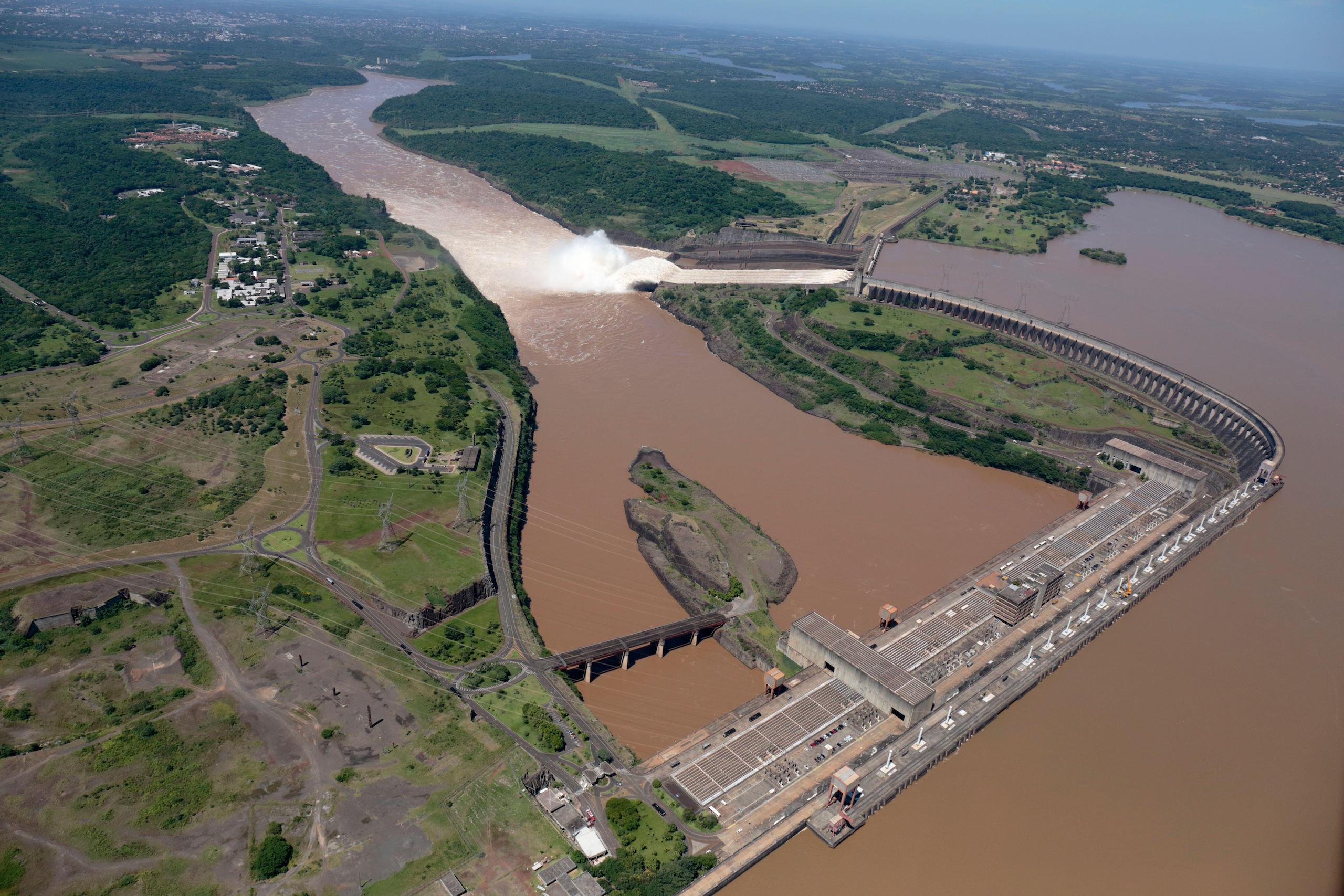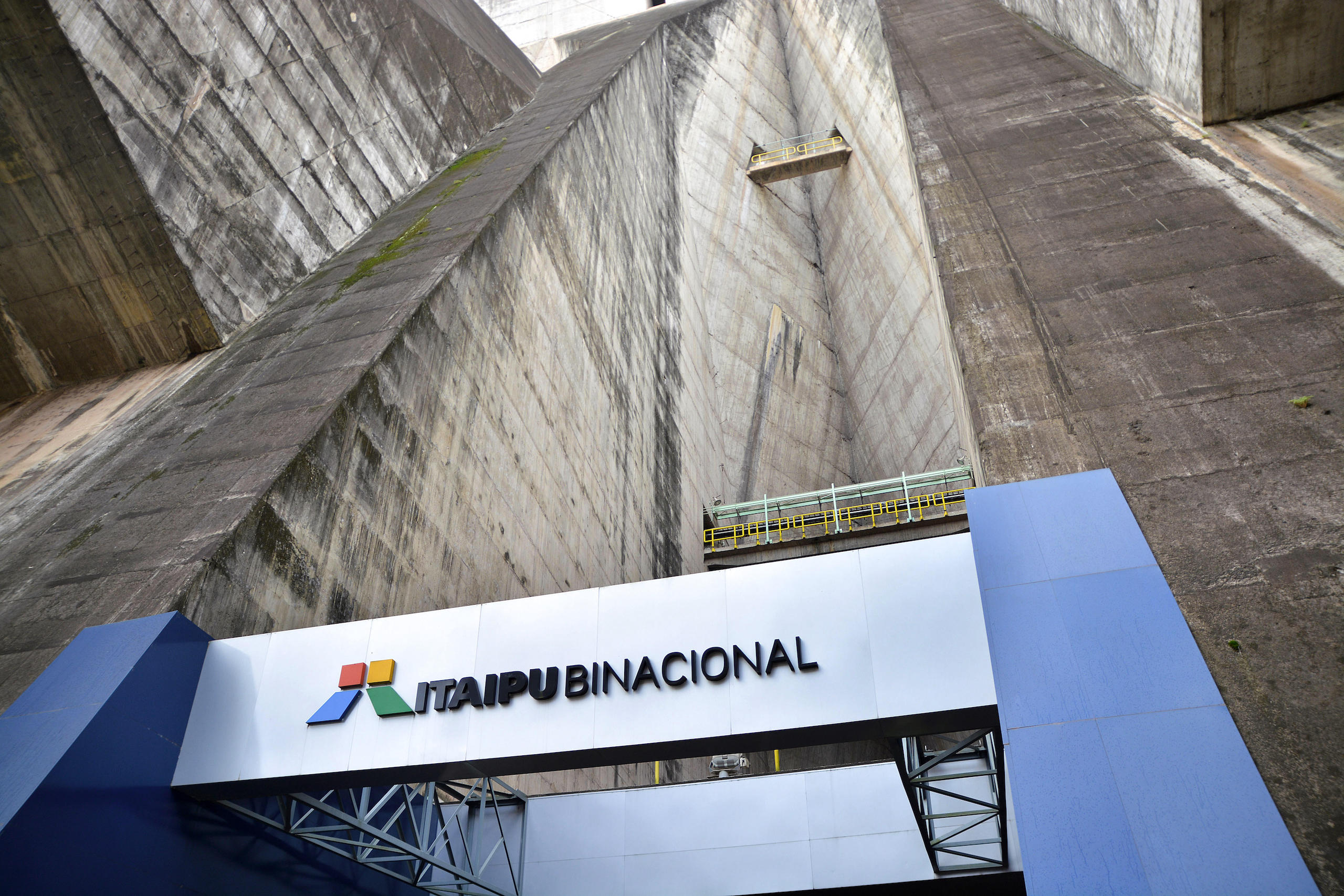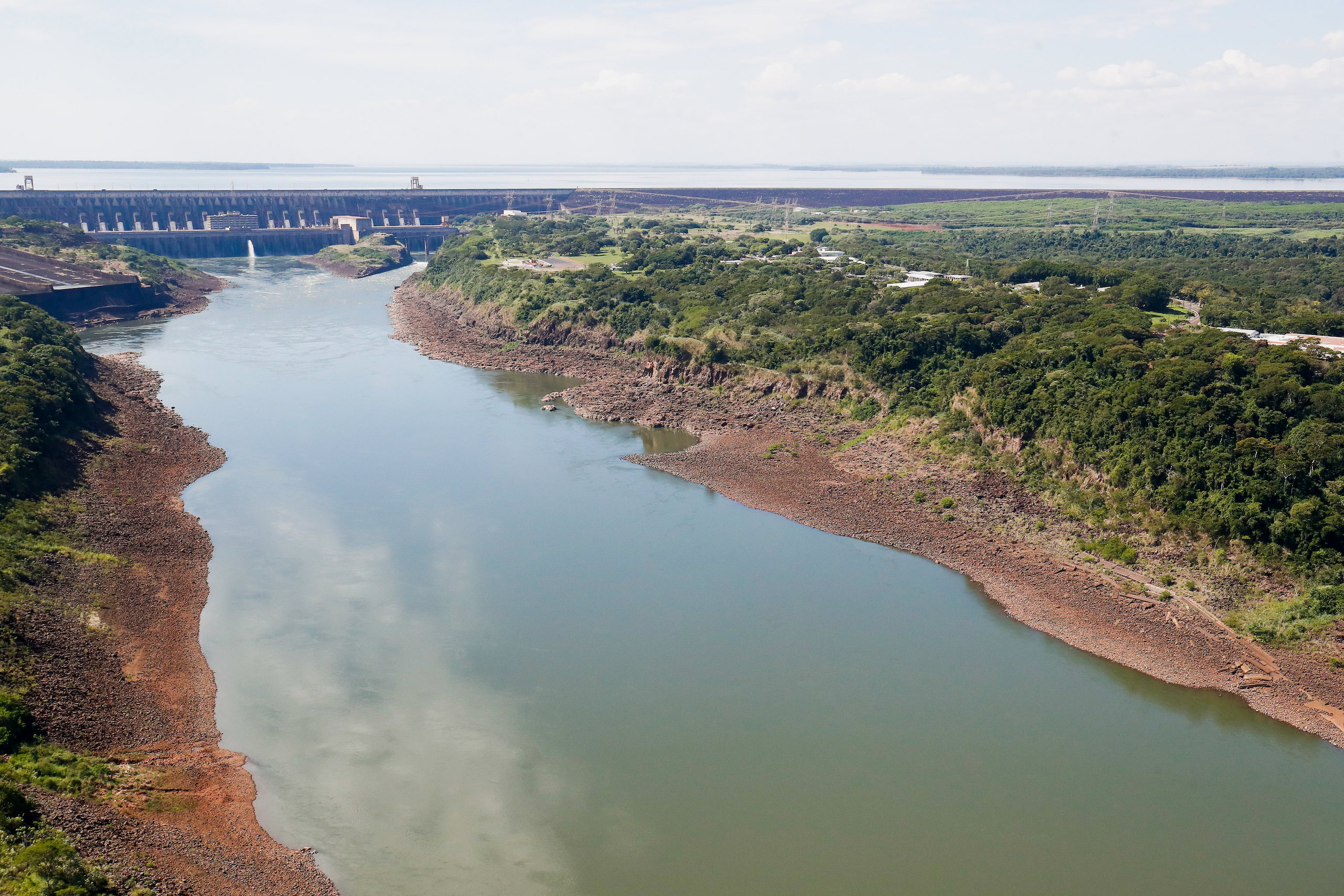As Paraguay’s new president Santiago Peña took office in 2023, another milestone was being reached at the nation’s eastern border with Brazil. The bilateral agreement that created the mammoth Itaipu dam – the world’s third-largest hydropower station, shared by the two countries – reached its 50th anniversary, triggering a renegotiation of its terms.
This deadline, agreed with Brazil half a century ago, may have come at an opportune moment for the country: improving its terms and access to renewable energy from the dam “could be a magic key for Paraguay’s energy transition”, says Guillermo Achucarro, a Paraguayan climate policy researcher.
Across the border, Brazil’s president Luiz Inácio Lula da Silva is back, returning to office in 2023 for a third time, 12 years after his last term. It was during Lula’s previous government, in 2009, that an historic agreement was reached to triple the amount Brazil pays to Paraguay for Itaipu’s energy.
Under the terms of the original treaty, Paraguay has sold much of the energy to which it has been entitled – half of the dam’s output – to Brazil at a preferential price. The arrangement is a contentious one in Paraguay as, to this day, it still must cede any energy it does not use domestically to Brazil.
Several factors have threatened the prospects of the renegotiation, including disagreements over the pricing of energy from the dam, the pressures of climate change – likely to impact future output – and an increasing possibility that Paraguay will need to retain all its energy entitlement for its own consumption.
A ‘dream’ born from conflict
Paraguay’s President Peña has spoken of Itaipu’s creation as the fruit of Brazilians and Paraguayans who “dared to dream”. In practice, the dam’s story has been somewhat less idyllic.
Latin American historian Jacob Blanc has detailed how the 1973 Itaipu treaty emerged from a diplomatic rift over differing interpretations of the Brazil-Paraguay border, since it had been demarcated at the end of the War of the Triple Alliance (1865–1870), in which the two countries had been adversaries. In June 1965, forces of the Brazilian military dictatorship occupied the area, where it had identified hydropower potential a decade earlier. Four months later, armed guards detained a Paraguayan delegation visiting the site, which included allies of Paraguay’s then-president, the dictator Alfredo Stroessner.
What followed was a year of active regional diplomatic conflict, including threats of war, mediated by the United States. In 1966, Paraguay and Brazil signed the Iguazú Act, in which they agreed to jointly explore the area’s hydropower potential. The 1973 treaty later declared Itaipu a “binational entity”. The disputed territory was to be dammed and flooded, formally settling the conflict.
The treaty forged an “equitable division of energy and administration”, notes Tomaz Espósito Neto, a scholar of Brazil-Paraguay relations. But it also created a controversy: while Paraguay assumed its share of the dam’s construction costs, the country’s lack of hydropower infrastructure at the time led to its agreement to cede to Brazil any energy unused from its entitlement of 50% of the dam’s output.
In 1975, as the project got underway, Brazil and Paraguay together took on debts of just over USD 3.5 billion, including loans via Brazilian state utilities company Electrobras. Independent analysts estimate this debt had grown to USD 79 billion by the time it was fully paid off in 2023: the figure ballooned amid accusations of overbilling for construction and the refinancing of initial loans with Brazil. In addition, the lending banks raised the cost of repayment to recoup its losses from a below-cost energy tariff used between 1985 and 1997, which had benefited the Brazilian industries that were using the majority of Itaipu’s power.
Questions have been raised by some social organisations and political parties in Paraguay over what has been described as a “spurious” debt. A 2013 report overseen by the US-based Columbia Center on Sustainable Investment also concluded that Paraguay had in fact already paid off its share, particularly as “careful accounting of all costs and prices would show that Brazil has underpaid Paraguay very significantly for decades”.
Itaipu’s status as a binational entity with its own treaty, diplomatic status and framework means it operates on its own legal basis. As such, the debt calculations for the project were never officially audited. Due to court rulings declaring Itaipu to be under no obligation to report to anyone beyond its board of directors, for decades neither Paraguay nor Brazil were able to control the dam’s finances: its debts were ultimately paid by being passed on to electricity customers in both countries, explains Mercedes Canese, a Paraguayan researcher and member Itaipu National Cause, a group campaigning for a fair and transparent renewal of the treaty.
Renegotiations: more than just tariffs
With the debt paid off and the stipulated 50 years having passed last October, the process of revising Annex C of the Itaipu Treaty formally began. Annex C determines Itaipu’s hydropower generation costs, which, in theory, should be shrinking. But several factors stand in the way of this.
One is the tariff the Itaipu company charges suppliers – and ultimately consumers – for the energy it produces. A key determinant of the energy cost at the dam has historically been its debt, but as this becomes a lesser concern, Brazil has proposed a reduction in this tariff. According to Itaipu’s 2022 annual report, Brazil consumed 75% of the energy the dam produced that year, while Paraguay used the remaining 25% of hydropower generation to cover 86% of its 2022 electricity demand. As a seller of much of its entitlement, Paraguay wishes to raise the tariff.
Paraguayan foreign policy analyst and author Julieta Heduvan tells Dialogue Earth that relations between presidents Peña and Lula have so far been “extremely positive”. However, she also acknowledges that international negotiations “always have winners and losers”.
“Paraguay is at a disadvantage because of its relative position in the world and the enormous asymmetries it has in relation to Brazil,” Heduvan adds.
After a bilateral meeting with Peña in January 2024, Lula recognised their differing views on the tariff charged by Itaipu; the Brazilian president was reportedly “annoyed” at being underprepared, as Paraguay applied pressure on Brazil to raise it.
On 7 May, with Brazil’s energy minister Alexandre Silveira in Asunción for talks, Brazilian paper O Glóbo reported that an agreement had finally been reached on the tariff, set to rise to USD 19.28 per kilowatt by 2026 – a figure much closer to Paraguay’s original proposals. Paraguayan and Brazilian media had alternately reported that the two numbers being put forward from Asunción were for USD 20.75 or USD 22.23 per kW. According to Espósito, Brazil had wanted to keep the tariff closer to its current level, USD 16.70 per kW, but there has been “a lot of pressure to lower it to between 12 and 14 dollars to favour its local industry”.
The amount is also higher than what sources close to the Brazilian foreign ministry had told Espósito: that the maximum tariff Brazil would consider is USD 18 per kW.
The final agreement, if signed, would be a victory for Paraguay, which could receive an additional USD 600 million dollars from Itaipu by 2026.
Paraguay is at a disadvantage because of its relative position in the world and the enormous asymmetries it has in relation to BrazilJulieta Heduvan, Paraguayan foreign policy analyst
Amaro Pereira, an energy economist from the Federal University of Rio de Janeiro, told Dialogue Earth that the Brazilian energy system “can maintain itself without surplus energy from Paraguay. The issue is that energy from Itaipu is cheaper and, without this surplus, there could be an impact on energy prices.”
Prior to the announcement, Espósito had considered that an amount similar to that agreed would “generate political tensions” in Brazil because of the possible impact on Brazilian consumers. However, according to O Glóbo, sources from the Brazilian energy ministry argued that this would not be the case and that the difference between the current tariff and the new one would be covered with funds from the dam.
A make-or-break issue?
Itaipu “plays a greater political, economic and symbolic role in Paraguay than in Brazil,” explains Sara Costa, a researcher for Paraguay’s Itaipú Ñane Mba’e (Itaipu Our Heritage) campaign.
Issues around the dam have made – and nearly broken – several Paraguayan presidents: Fernando Lugo (2008–2012) was elected on the promise of increased compensation from Brazil; in 2019, Peña’s predecessor, Mario Abdo Benitez, was in danger of impeachment after he was linked to an opaque deal with a company called Leros, which had ties to Brazil’s then-president, Jair Bolsonaro. The deal allowed the company to buy Paraguay’s surplus Itaipu energy at a subsidised price, before selling it on the Brazilian market at a mark-up.
The dam supplements tax revenue in Paraguay, which Canese notes has the lowest tax-to-GDP ratio in South America. The royalties received by the state from the dam’s company for its use of the Paraná River, upon which the dam is situated, finance everything from the construction of schools and health centres, to scientific research and entire municipalities.
One example of this is a new policy of the Peña’s administration to channel proceeds from Itaipu towards an ambitious “Zero Hunger” project of school meals. Creating this project, however, meant diverting money away from other policies, such as free admission to universities, a fund for cancer treatments, another for mental health, and the financing of scientific research. This sparked a series of strikes, and a student-led, two-week takeover of universities across the country, before the government agreed to engage in discussions with school representatives to secure more funding.
Costa and Canese agree that Peña’s desire to obtain a high tariff from Brazil has been to guarantee the availability of funds that the government obtains through Itaipu’s revenues. But both point out that this position could be illegal, as the Itaipu Agreement states that the cost of the tariff must be equal to operating costs. Costa says that, legally, Itaipu is not allowed to turn a profit.
“The discussion of the tariff is being confused with the revision of Annex C, which is something much broader,” Costa says, something acknowledged in Brazil and Paraguay’s own announcement on 7 May. While an agreement on the tariff was reached, discussions over Annex C are still yet to move forward.
She adds that although this broader discussion should include the matter of why the tariff should be increased or decreased, “behind this question is the issue of development, for which Itaipu is a strategic asset”.
Costa reasons: “If what I want is to use the energy to industrialise or electrify [Paraguay], then what I want is for the energy to be cheap – not to go up, as the Peña government wants.” The arrangement Paraguay is pushing for means it would withdraw the total amount of energy it is entitled to. Though this would eliminate the income from the concession to Brazil, it could allow Paraguay to freely sell energy to other buyers at a better price.
Espósito says that if Paraguay were to draw on its entire entitlement, “it would increase the cost of electricity in Brazil a lot.” He believes Paraguay does not have the distribution network to do this – though the state claims otherwise.
In any case, it may only be a matter of time before Paraguay will need to use all its energy entitlement from Itaipu for the domestic market. The country’s electricity consumption is increasing, owing in part to the growth of energy-intensive industries such as cryptocurrency mining, and the prospect of green hydrogen production. According to a government report from 2021, domestic consumption is likely to overtake generation capacity between 2028 and 2033. However, Canese notes that the report’s calculations do not include the impact of climate change on consumption, which is likely to further increase electricity use.
Climate change threats
Despite the availability of renewable energy in Paraguay, with hydropower already covering nearly all electricity consumption, the country continues to depend on fossil fuels and biomass for its transport and industrial sectors: as of 2021, fossil fuels still accounted for 29% of the country’s total energy mix, while biofuels covered 33%. If “a fair negotiation” is achieved, says researcher Achucarro, Itaipu “could be a pathway to decarbonisation, and a profound change in the Paraguayan energy mix”.
Espósito, however, cautions that the same energy that could be used to decarbonise the Paraguayan economy currently stops Brazil from needing to explore the Amazon Basin for its oil and gas potential. Without access to Paraguay’s cheap hydroelectricity, he says, Brazil would likely supply the short-term shortfall with fossil fuels.
Paraguay’s energy consumption is also being driven up by the growth in heatwaves, while a wave of planned green hydrogen investments is raising the prospect of further demands on electricity. One such hydrogen investor looking to take advantage of Paraguay’s relatively cheap electricity is the fertiliser company Atome Energy, which requires hydrogen to make the ammonia in its products. Atome’s president, James Spalding, is a former Paraguayan director of Itaipu.
Organisations have complained about this potential conflict of interest, and that Atome stands to benefit from a lower tariff that does not take into account the electricity-intensive nature of its hydrogen production.
Demand for hydrogen is increasing because it does not produce greenhouse gases when burned.
⚪️ Fossil fuels have traditionally been used to produce the hydrogen. This is known as “grey” hydrogen.
🔵 “Blue” hydrogen is also produced using fossil fuels, but alongside carbon capture and storage technology, which claims to stop the resulting greenhouse gas emissions from reaching the atmosphere.
🟢 Hydrogen can only be classified as “green” if it was produced through the electrolysis of water, using renewable electricity only.
A formal complaint filed by the campaign group Itaipu National Cause (ICN) claims the Paraguayan state stands to lose USD 117 million by charging an out-of-date tariff to Atome. Spalding rejects these accusations, telling Dialogue Earth that Atome’s operations in the country will mean “Paraguay will increasingly be using the clean and renewable energy available for its own sustainable industrial development.”
Increased energy consumption is not the only challenge facing Paraguay. In 2021, the Paraná Basin, upon which Itaipu depends, endured one of its worst droughts on record. This caused problems for the electricity sector, says Saulo de Souza, a Brazilian engineer and climate change coordinator at the National Water and Sanitation Agency (ANA). The dam’s 2021 annual report recorded its lowest revenues since Itaipu began operations in 1984.
Souza, who authored a 2024 study about the impact of climate change on water resources, concludes that the hydropower sector will have to cope with more floods and droughts – “which will lead to greater operational difficulties”.
One flood mitigation measure has been to protect the forests along the banks of the Paraná River. To this end, says Canese, it is important to settle another of the Itaipú dam’s historical debts: the one it owes to the area’s Indigenous peoples, such as the Ava Guaraní people, who were expelled from their lands by state dictatorships under the pretext of building the plant.
An investigation by the Paraguayan newspaper Ultima Hora revealed that ancestral lands were, in many cases, ceded to agribusinesses and private organisations during the construction of the dam in the 1980s. When the Ava Guaraní tried to return to their territory in 2017, Itaipu filed an eviction lawsuit, which Paraguayan courts rejected in 2023. “The Ava Guaraní are doing us a favour by wanting to return to their territory,” says Canese. “If we don’t have a restored ecosystem, we don’t have water.” Though the case was rejected, the Ava Guaraní are still facing a fight for their lands.
For Paraguay to renegotiate the Itaipu treaty in a way it deems successful, Julieta Heduvan believes it “must generate a new strategy … to bet on greater regional integration that allows for common benefits.”
Espósito, meanwhile, thinks Brazil could navigate potential disagreements by proposing a 10-year transition period with variable energy tariffs; this could accommodate rising energy consumption in Paraguay as it grows increasingly industrial and urbanised.
But, Heduvan concludes: “To reach an agreement, someone has to give more.”











